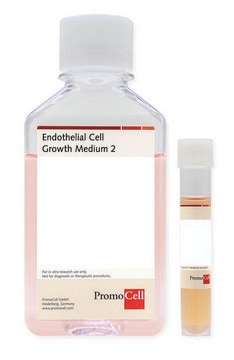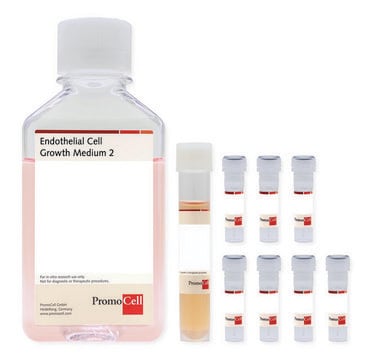C-12203
Human Umbilical Vein Endothelial Cells (HUVEC)
Pooled, 500,000 cryopreserved cells
Sinónimos:
HUVEC cells
About This Item
Productos recomendados
origen biológico
human umbilical cord vein
envase
pkg of 500,000 cells
morfología
( endothelial)
técnicas
cell culture | mammalian: suitable
Condiciones de envío
dry ice
temp. de almacenamiento
−196°C
Categorías relacionadas
Descripción general
Origen línea celular
Aplicación
Calidad
Advertencia
Rutina de subcultivo
Otras notas
Productos recomendados
Cláusula de descargo de responsabilidad
Código de clase de almacenamiento
12 - Non Combustible Liquids
Clase de riesgo para el agua (WGK)
WGK 1
Punto de inflamabilidad (°F)
Not applicable
Punto de inflamabilidad (°C)
Not applicable
Certificados de análisis (COA)
Busque Certificados de análisis (COA) introduciendo el número de lote del producto. Los números de lote se encuentran en la etiqueta del producto después de las palabras «Lot» o «Batch»
¿Ya tiene este producto?
Encuentre la documentación para los productos que ha comprado recientemente en la Biblioteca de documentos.
Los clientes también vieron
Artículos
Yeast plasmid selection: Utilizes auxotrophic yeast strains for plasmid selection, enabling growth on synthetic media for better yield.
Overview of primary cells and media usage in biomedical culture applications highlights differences from cell lines.
Protocolos
Cell culture protocol: the endothelial cell transwell migration and invasion assay used to study angiogenesis and cancer cell metastasis. Explore over 350 PromoCell products.
Contenido relacionado
Cell culture protocol: the endothelial tube formation assay to study angiogenesis using HUVECs and other endothelial cell types. Explore over 350 PromoCell products.
Nuestro equipo de científicos tiene experiencia en todas las áreas de investigación: Ciencias de la vida, Ciencia de los materiales, Síntesis química, Cromatografía, Analítica y muchas otras.
Póngase en contacto con el Servicio técnico





